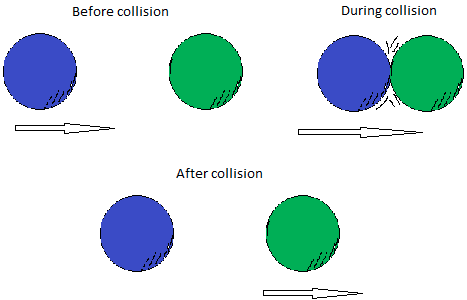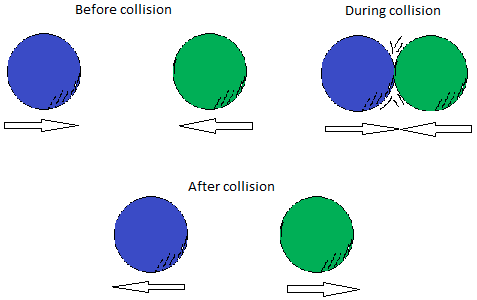Momentum and collisions
Momentum and collisions are closely related in physics as you will clearly see in this lesson. Collisions occurs of course when objects collide. To keep things a little simple, we will focus on the collisions of two objects in this lesson.
How are momentum and collisions related?
The law of conservation of momentum is the law that relates or brings together momentum and collisions.
The law of conservation of momentum
When two objects collide in the absence of external forces, the net momentum of the objects before the collision is equal to the net momentum of the objects after the collision. Mathematically, we can write the equation below:
net momentum (before collision) = net momentum (after collision)
Remember that momentum = mv
Therefore, the following equation is law of conservation of momentum:
net mv (before collision) = net mv (after collision)
Types of collisions
There are two types of collisions. The first type is elastic collisions and the second type is inelastic collisions.
What are elastic collisions?
When a collision occurs between two objects and the objects are not permanently deformed and no heat is generated, we say that the collision is elastic. The word elastic probably came from the fact that when you stretch an elastic band, it will always go back to its original shape instead of being deformed.
Generally speaking, elastic collisions do not occur perfectly since some heat is usually generated during collisions. When objects collide without being permanently deformed and without generating any heat at all, we call this situation a perfectly elastic collision. However, perfectly elastic collisions are not likely to occur in the real world.
To solve problems involving elastic collisions, we will need to assume that the heat generated is negligible. We can also use two marbles since marbles are not usually deformed permanently after collision.
We can consider a couple of cases. The two cases below assume that the masses of the marbles are equal. The other important thing to keep in mind is that no momentum is loss or gain during the collision. Instead, the momentum is simply transferred. In the example below, the blue ball will transfer all its momentum to the green ball.
Case #1: Blue marble is moving toward green marble while green marble is at rest.

Notice that after collision, the blue marble is at rest while the green marble is now moving.
Suppose that the blue ball has an initial velocity equal to v before hitting the green ball. After hitting the green ball, the blue ball will have a velocity of zero and the green ball will now start moving with a velocity that is equal to the initial velocity (v) of the blue ball.
Real life examples of elastic collisions
- A billiard ball that is moving collides head-on with another billiard ball that is at rest.
- A ball is thrown on the ground. The ball bounces back to your hand.
- The collision between two marbles
- The collision between two atoms
Case #2: Blue marble and green marble are moving toward each other.

Notice that after collision both marbles move away from each other.
Furthermore, suppose that the blue ball has an initial velocity equal to vb and the green ball has an initial velocity equal to vg before hitting or colliding with each other.
After colliding with each other, the balls will exchange velocity. After the collision, the blue ball will have a velocity that is equal to the initial velocity of the green ball or vg and the green ball will have a velocity that is equal to the initial velocity of the blue ball or vb.
What are inelastic collisions?
In inelastic collisions, the objects colliding will be deformed or distorted. However, after they collide, they can either blend together to form a single unit or they can bounce off each other.
This usually happens during automobile accident. Sometimes, one car hits another car, gets stuck to that car, and keep pushing it for a little while before coming to a full stop. Other times, the collision is head-on and the cars bounce off.
Real life examples of inelastic collisions
- A freight car moves towards another freight car and then they collide. After the collision they blend together to form a single unit.
- A truck colliding with a tree. The truck is deformed and comes to a complete stop.
- Kicking a soccer ball.
- You damage the wall after punching it.
Collisions usually occur with some external force. For example, billiard balls will not continue to move indefinitely after being given some momentum. Friction created by the table and the air will slow down the ball.
Now you are ready to solve some momentum and collisions word problems.